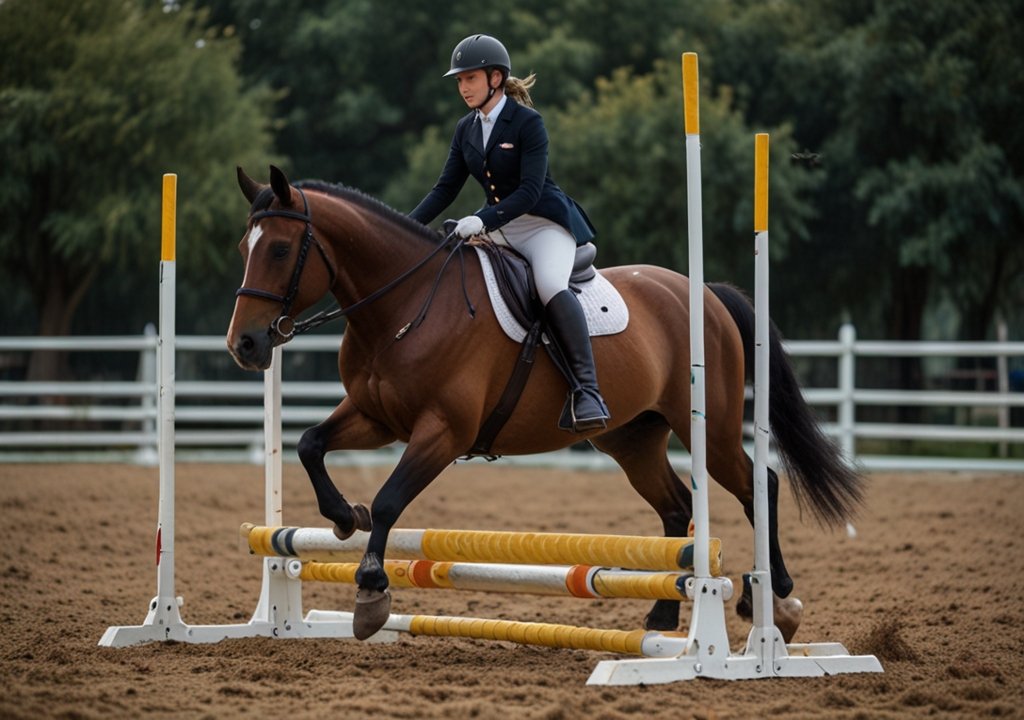Key Takeaways:
- Jump poles are fundamental tools in equestrian training, aiding in developing horse and rider skills.
- They help improve both horses’ and riders’ balance, agility, coordination, and confidence.
- Understanding how to set up and use jump poles effectively is crucial for maximizing their benefits.
Table of Contents:
- Introduction
- Basics of Jump Poles
- Importance in Equestrian Training
- Technical Aspects and Guidelines
- Designing Effective Training Exercises
- Safety Considerations
- Conclusion
Introduction
Jump poles are a staple in the equestrian world, serving as versatile training tools for riders and horses across many disciplines. These horizontal bars are laid on the ground or elevated to various heights to challenge and enhance horses’ skills, making them an essential component of any equestrian training regimen. Whether preparing for show jumping, eventing, or simply honing a horse’s agility and responsiveness, jump poles are integral to building foundational techniques and boosting overall performance. This article delves into the basics of jump poles, their importance in training, and methods for using them effectively.
Basics of Jump Poles
Jump poles, typically made from wood or lightweight materials like PVC, are used to create a variety of exercises that simulate operational competition environments or enhance basic riding skills. The standard pole measures 10 to 12 feet long and about 4 inches in diameter, although variations exist to accommodate different training needs and horse sizes. Jump poles are often painted with colorful stripes to help horses differentiate the poles visually, aiding in their focus and jump accuracy.
Understanding the basic placement and setup is essential for effectively utilizing jump poles. They can be laid flat on the ground, used as trot poles, arranged in grid patterns, or set on jump wings to create combinations of jumps. The positioning and spacing of these poles will vary depending on the desired type of exercise—be it groundwork, improving rhythm and cadence, or practicing more technical jumping maneuvers. The versatility of jump poles makes them an indispensable asset to any training program.
Importance in Equestrian Training
The use of jump poles in training provides myriad benefits that extend far beyond merely learning to jump over obstacles. For horses, these poles encourage a natural lift in their stride, promoting improved balance and coordination. Trotting over poles enhances a horse’s ability to engage its hindquarters, which is crucial for developing strength, propulsion, and a more effective jump. Furthermore, jump poles teach horses to lengthen and shorten their stride safely, thus helping them navigate different distances and jump types smoothly.
From a rider’s perspective, the strategic use of jump poles develops key skills such as balance, timing, and communication with the horse. They allow riders to practice maintaining a steady rhythm and tempo, which is critical when clearing jumps. The riders build their confidence and instinctive responses by concentrating on steering, pacing, and positioning. Additionally, these exercises encourage riders to develop a sharper sense of awareness and adaptability, essential traits for competitive riding.
Technical Aspects and Guidelines
When integrating jump poles into equestrian training, understanding technical aspects is vital for achieving intended outcomes without compromising safety. Key considerations include the distance between poles, their height, and the sequence or pattern used with other elements such as cavaletti or small fences. For example, trot poles are spaced approximately 4 to 5 feet apart, which matches the natural stride length of most horses, while canter poles can be set at intervals of 9 to 12 feet.
Adjusting the poles’ height using block or cone risers can introduce a new dimension to training, as raised poles require horses to lift their legs and engage their muscles more intensely. As horses and riders gain proficiency, altering pole configurations, incorporating varied patterns, and combining work over poles and jumps can make training challenging yet enjoyable. Trainers and riders need to start with basic setups and gradually increase complexity to build the horse and rider’s competence and confidence safely.
Designing Effective Training Exercises

Creating various exercises incorporating jump poles can significantly enhance the overall training experience. One popular exercise, the grid, involves a series of poles or jumps arranged in a pattern that promotes rhythm and precision. Grids can be customized with different spacings, elevating challenges for the horse and rider. Similar setups, like bounce grids, require quick response times, improving agility and reaction speeds.
Training exercises often begin with simple ground pole configurations focusing on rhythm, transitions, and general fitness. Progressing to raised poles introduces height and complexity, fostering accuracy in foot placement and improved muscle engagement. Advanced exercises might involve combinations that simulate real course conditions, testing a horse’s ability to adjust strides and maintain flow. Practical training with jump poles requires creativity, patience, and a structured approach, ensuring constant skill development without overexerting the horse.
Safety Considerations
Safety is paramount when utilizing jump poles in training, protecting both horse and rider from injury. Riders should wear appropriate safety gear, such as helmets and boots, and horses must be checked for proper shoeing and soundness before each session. Furthermore, ensuring a safe footing, such as a well-maintained arena surface, can prevent unnecessary slips or trips during exercises.
Obstacles should be constructed with secure equipment, and poles should be regularly inspected for structural integrity. Avoid using excessively worn or damaged poles that may break under pressure, posing risks. It’s beneficial to have knowledgeable supervision to offer guidance on appropriate exercises and prevent safety oversights. By adhering to these practices, jump poles can be a safe and rewarding part of equestrian training.
Conclusion
Jump poles are invaluable in cultivating a well-rounded equestrian training program. They offer endless opportunities to refine horse and rider skills, from basic groundwork to complex jumping techniques. By fostering physical strength, mental agility, and essential collaboration skills, jump poles contribute significantly to the training journey. Understanding their setup, implementation, and associated safety protocols maximizes their effectiveness while ensuring an engaging and safe experience. With diligent practice and creative application, jump poles enhance equestrian skills and deepen the bond between horse and rider.











